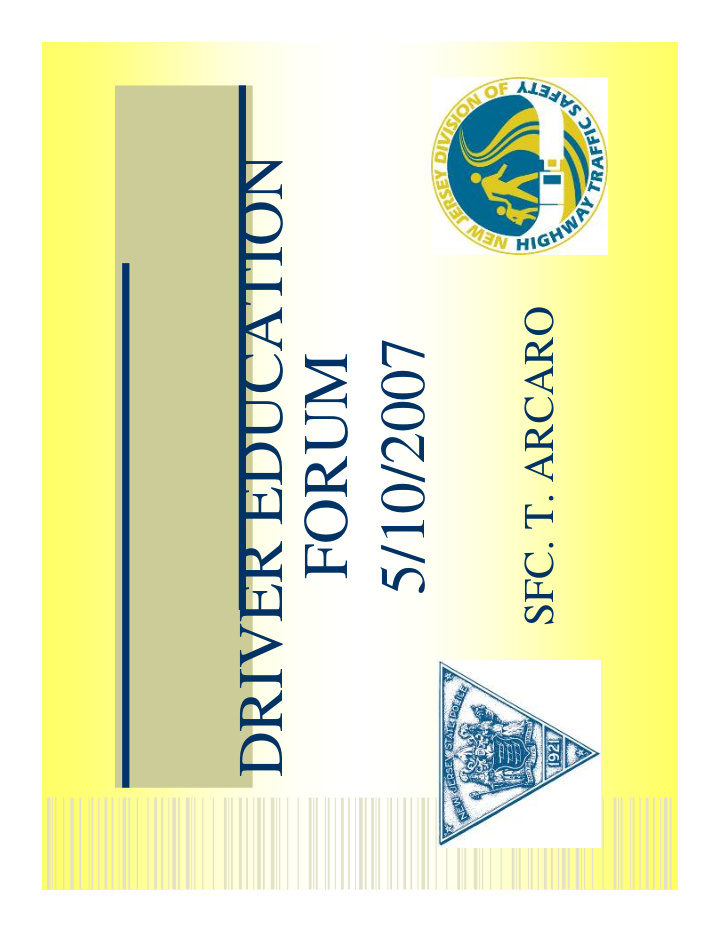



DRIVER EDUCATION SFC. T. ARCARO 5/10/2007 FORUM
CRASHES � Motor vehicle crashes are the leading cause of death for people ages 16 through 24 years old.
FATALS � The fatality rate for young drivers 16 through 19 years old is about 4 times as high as the rate for drivers 25 through 69 years old.
General statistics • Each child born today can expect to live, on an average to 78 yrs old. • 1 out of every 90 will die violently in a motor vehicle crash. • NJ averages 2 deaths per day. • More than half of all deaths involving crashes of 16-17 yrs olds occur when passengers u/20 are being transported without adults in the vehicle
WHAT CAN WE DO ABOUT THE FATALITIES? � How can you help? � What is the most important issue that we can teach? � What about the parents guide? Use as a tool in your schools and have parents sign it.
SEATBELTS #1 � Encourage the use of wearing a seatbelt and tell the driver to encourage all passengers! � NHTSA study found males were less likely to wear seatbelts. � Age group 16-24 year olds were less likely to buckle up.
Pre-Operation Checks Exterior of Vehicle � Lights – clean and all operational � Mirrors – clean and operational � Tires – pressure, damage, tread � Windshield and Wipers
Pre-Operation Checks Interior of Vehicle • Adjust seat and headrest • Fasten seatbelt • Adjust mirrors • Adjust climate control • Secure all loose objects • Start engine, check all gauges
Proper Driving Position � Sit upright in the seat � Pull the seatbelt tight � Brace yourself with your left leg
Distracted Driving Common Distractions: #1 is changing the radio/CD • Unknown Destination • Multi-tasking • • Cell phone • Be aware distracted drivers around you. • Makeup
Driving Tips � Scan the road ahead � Highway � Constantly check mirrors, blind spots � Try to anticipate other vehicle actions – “what if?” � City � At intersections, scan right, left and ahead � Cover the brake through intersections and when passing hazards
Driving Tips � Following Distance � Use the three-second + rule to determine safe distance.
Driving Tips � Stopping Distance � Perception distance + Reaction distance + Braking distance = Stopping distance � At 55 mph, 140 ft + 60 ft + 144 ft = 344 ft � At 65 mph, 440 ft � By covering the brake, you can reduce or eliminate the reaction distance (60 ft at 55 mph.)
Driving Conditions � Weather � Use common sense � Reduce speed � Increase following distance
Driving Conditions � Road Surface � Be aware of changing road surface conditions. � Dirt roads � Weather-related � Blind curves
Driving Conditions � Daytime Lighting � Use sunglasses and visors for bright sun. � Nighttime Lighting � Look down to road and roadway lines rather than at oncoming lights. � Use rearview mirror night setting � Use high beams when necessary � Adjust your speed to the range of the headlights (don’t overdrive)
OTHER HIGHWAY USERS � Trucks-fully loaded @ 60mph=nearly 10 million lbs of force. � Motorcycles-stop in a shorter distance. � Pedestrians, scooters, bicyclists- know where they should be traveling.
Driving Conditions � Traffic � Teach driver that different times of the day will make it more stressful. � Traffic back-ups and heavy merges = HIGH CRASHES
3 & 9 Hand Position 12 11 1 10 2 9 3 Right hand Left hand 8 4 7 5 6 Light pressure with fingers Firm pressure with thumbs
Emergency & Evasive Driving Techniques Move to right, away from oncoming traffic � Drive off the road if necessary � Maintain control by not skidding � Hit an object that will absorb energy � If you can choose, hit something � going in the same direction rather than stationary � stationary rather than oncoming � Never hit anything head-on, use a sideswipe if possible
Negotiating Intersections � Common location for crashes � Approximately 1/5 th of accidents � Adjust speed to allow for scanning � Slow down and cover the brake � Look & listen for hazards
Unregulated Intersections � An intersection that does not have any traffic control devices � When two vehicles enter from two roads at the same time, the driver on the left must yield to the driver on the right � Do not take this for granted
Teaching the GDL to new drivers � What is the purpose of the GDL law? � To reduce young drivers exposure to crash risks and to save lives!
Enforcement of the GDL laws � Must have probable cause to stop the motor vehicle. � Cannot “guess” the age of the driver by looking at a passing vehicle. � Can summons the GDL holder as well as the “adult” supervisor. � Fines do not adequately address violation for the new driver.
PROVISIONAL DL � 17 yrs and older and up – all restrictions apply. � 21 and older driver or passenger – no restriction for passenger nor hours driven.
OTHER ISSUES WITH PROVISIONAL DL � Other passenger over 21 doesn’t have to have valid DL! � Can operate with bona fide employment or religious activity note.
CRASH RISK � Highest crash risk is at lifetime high during the first 12-24 months of driving. � We can make a difference if we save one life.
Recommend
More recommend